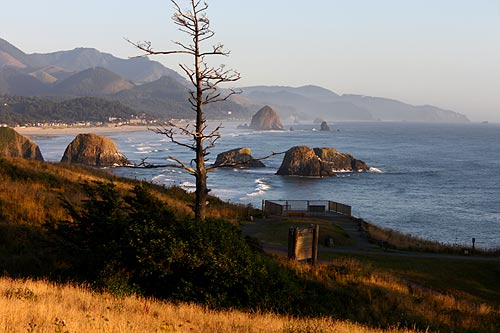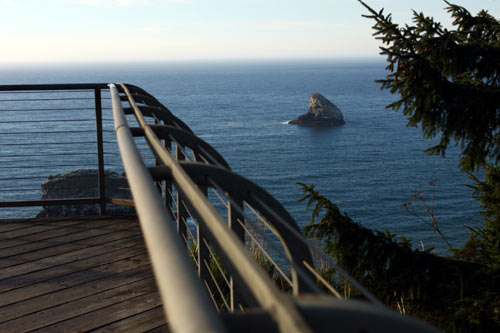 |
Fascinating Wildlife Displays on Oregon Coast Now, Including Deer Fawns
Published 06/13/2013

(Oregon Coast) – Plenty of places along the Oregon coast are exhibiting some wondrous wildlife scenes, according to Oregon Department of Fish and Wildlife (ODFW). Birds like bald eagles, puffins falcons and more are making quite the spectacle right now – but also young deer can be seen in coastal forests. (Above: puffin photo by Seaside Aquarium)
ODFW said seabird nesting is in full swing at the moment. Bald eagles and others can be spotted attacking the nests of common murres. Around 600,000 common murres return to each spring to Oregon’s wind-blown islands to raise their single chick.

As the murres flee to avoid the eagles, ravens, crows and gulls often swoop in to make a meal of murre eggs and chicks.Great places to view this wildlife spectacle are: Yaquina Head Outstanding Natural Area in Newport at the deck behind the lighthouse; Heceta Head State Park near Florence at the viewing area in front of the lighthouse; Cape Meares State Scenic Viewpoint (near Oceanside) at the north deck by the parking lot, and Ecola State Park (Cannon Beach) at the westernmost viewing platform at Ecola Point overlook.
Peregrine falcons and their young are visible at Yaquina Head and Cape Meares State Scenic Viewpoint.

Now through July is a great time to see puffins, ODFW said, usually in Cannon Beach.
“Best Place is Haystack Rock because it’s so close to shore,” ODFW said in a recent bulletin.
Tufted puffins are back on the Oregon Coast to nest for the summer and most of them are found on Three Arch Rocks National Wildlife Refuge at Oceanside.
“The three large rocks and six smaller ones make up the refuge, which is home to 12 species of seabirds breed here totaling 226,093 birds,” ODFW said.

More than 800 brown pelicans have been seen here roosting and up to 13 bald eagles have been observed preying on seabirds.
The coming extreme low tides of June not only make for excellent tide pool exploration but they open sightings for some kinds of rarely seen birds.
“Numerous rocky points jut out from Ecola State Park to Cascade Head and support breeding colonies of pelagic cormorants, pigeon guillemots and others,” ODFW said.
Keep a look out for black oystercatchers foraging on wash rocks exposed by the tide. They can be difficult to see: look for the bright orange bill and listen for high, trilling calls among the rocks.
The sunnier days of June bring more black-tailed deer fawns to frolic in area pastures and openings near brush and timber. ODFW said does may spend extended periods away from their young while foraging so as not to attract predators to their immediate area; returning only to nurse in the dark of night.
Fawns will stay curled up in tall grass during this time. But ODFW warned to never assume a fawn has been orphaned just because a doe is not seen nearby. Later, several does with young may group together as they more actively forage clearcut areas and forest roadsides once the fawns begin the switch to solid food.
More about the Oregon Coast below
More About Oregon Coast hotels, lodging.....
More About Oregon Coast Restaurants, Dining.....
LATEST Related Oregon Coast Articles
Oregon Coast, Valley and Likely Washington Coast to Get Some Aurora Borealis ... |
Back to Oregon Coast
Contact Advertise on BeachConnection.net
All Content, unless otherwise attributed, copyright BeachConnection.net Unauthorized use or publication is not permitted
Secrets of the Season |
Unusual Travel Articles TravelParanormal.com allows you to submit your own creepy tale or debunk one - or see up-to-the-minute news headlines about travel and the paranormal. News Headlines from All Over Oregon Need to scan Oregon headlines? Constantly updated news from all over Oregon: a comprehensive, up-to-the-minute display of news headlines from a variety of media |









































